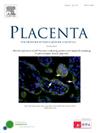Characterization of placental pathology in Beckwith-Wiedemann Syndrome due to alterations in the KCNQ1OT1:TSS-DMR region
IF 2.5
2区 医学
Q2 DEVELOPMENTAL BIOLOGY
引用次数: 0
Abstract
Introduction
Beckwith-Wiedemann Syndrome (BWS) is an imprinting disorder characterized by fetal and placental overgrowth. BWS is most often caused by genetic and epigenetic alterations involving the KCNQ1OT1-TSS:DMR (IC2) imprinting control region which alters expression of CDKN1C (p57KIP2). Here we report a cohort of patients with BWS primarily due to defects at IC2 compared to a well matched, non-BWS cohort to establish the placental features associated with these BWS subtypes.
Methods
This is a retrospective case-control study. Our cohort of 28 patients with BWS were matched to a non-BWS cohort of 28 unaffected patients. The rate of clinical and pathological features in the BWS and non-BWS cohorts were compared. Additionally, the associations between loss of p57KIP2 staining in the BWS cohort, placental pathology, and clinical outcomes were analyzed.
Results
We identified key pathological features in the placenta associated with BWS including placentomegaly, umbilical cord edema, abnormal chorionic vascular pattern, macroscopic cysts, stem villous stromal expansion, and abnormal extravillous trophoblast (EVT) morphology. We found that placental overgrowth in BWS is disproportionate to fetal overgrowth. We also identified associations between abnormal EVT morphology, loss of p57KIP2 staining, and rates of prematurity in patients with BWS.
Discussion
Novel features associated with BWS identified in this work can be used to inform the diagnosis of BWS when examining the placenta. Additionally, by establishing associations between adverse pregnancy outcomes and abnormal EVT morphology, we identified a potential mechanism for the increased risk of prematurity in pregnancies complicated by BWS.
kcnq10t1:TSS-DMR区改变对贝克威思-魏德曼综合征胎盘病理的影响
简介:贝克威斯-魏德曼综合征(BWS)是一种以胎儿和胎盘过度生长为特征的印记障碍。BWS通常是由涉及kcnq10t1 - tss:DMR (IC2)印记控制区的遗传和表观遗传改变引起的,该区域改变了CDKN1C (p57KIP2)的表达。在这里,我们报告了一个主要由于IC2缺陷而患有BWS的患者队列,与一个匹配良好的非BWS队列进行比较,以建立与这些BWS亚型相关的胎盘特征。方法:回顾性病例对照研究。我们的28例BWS患者队列与28例未受BWS影响的非BWS患者队列相匹配。比较BWS组和非BWS组的临床和病理特征率。此外,我们还分析了BWS队列中p57KIP2染色缺失、胎盘病理和临床结果之间的关系。结果:我们确定了与BWS相关的胎盘的主要病理特征,包括胎盘肿大、脐带水肿、绒毛膜血管模式异常、宏观囊肿、干绒毛间质扩张和异常的胞外滋养细胞(EVT)形态。我们发现BWS胎盘过度生长与胎儿过度生长不成比例。我们还发现了EVT形态异常、p57KIP2染色缺失和BWS患者早产率之间的关联。讨论:在这项工作中发现的与BWS相关的新特征可用于在检查胎盘时告知BWS的诊断。此外,通过建立不良妊娠结局与EVT形态异常之间的关联,我们确定了妊娠合并BWS时早产风险增加的潜在机制。
本文章由计算机程序翻译,如有差异,请以英文原文为准。
求助全文
约1分钟内获得全文
求助全文
来源期刊

Placenta
医学-发育生物学
CiteScore
6.30
自引率
10.50%
发文量
391
审稿时长
78 days
期刊介绍:
Placenta publishes high-quality original articles and invited topical reviews on all aspects of human and animal placentation, and the interactions between the mother, the placenta and fetal development. Topics covered include evolution, development, genetics and epigenetics, stem cells, metabolism, transport, immunology, pathology, pharmacology, cell and molecular biology, and developmental programming. The Editors welcome studies on implantation and the endometrium, comparative placentation, the uterine and umbilical circulations, the relationship between fetal and placental development, clinical aspects of altered placental development or function, the placental membranes, the influence of paternal factors on placental development or function, and the assessment of biomarkers of placental disorders.
 求助内容:
求助内容: 应助结果提醒方式:
应助结果提醒方式:


